- Co-ordinate geometry of a plane
Gradient of a line
Gradient (Slope) of a Straight Line
The gradient ( Also called slope) of a straight line shows how steep a straight line is
The method to calculate the Gradient is:
Divide the change in height by the change in horizontal distance
| Gradient = |
| 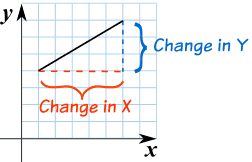 |
Examples:
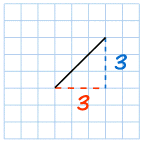 |
So the Gradient is equal to1
|
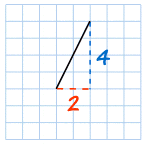 | |||||
| Gradient = |
| = 2 |
The line is steeper, and so the Gradient
is larger.
is larger.
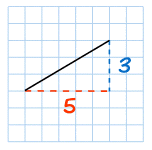 | ||||||
| Gradient = |
| = 0.6 | ||||
The line is less steep, and so the
Gradient is smaller.
Gradient is smaller.
Positive or Negative?
Important:
- Starting from the left end of the line and going across to the right is positive
(but going across to the left is negative). - Up is positive, and down is negative
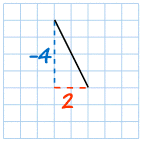 | |||||
| Gradient = |
| = –2 | |||
That line goes down as you move
along, so it has a negative Gradient.
along, so it has a negative Gradient.
Straight Across
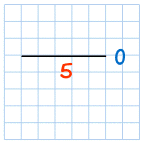 | |||||
| Gradient = |
| = 0 | |||
A line that goes straight across
(Horizontal) has a Gradient of zero.
(Horizontal) has a Gradient of zero.
Straight Up and Down
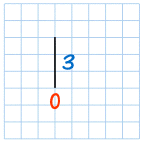 | |||||
| Gradient = |
| = undefined |
That last one is a bit tricky....you can't divide by zero. So a "straight up and down" ( Vertical) line is gradient is "undefined"
Parallel and perpendicular lines
Parallel and Perpendicular Lines
Parallel Lines
How do we know when two lines are parallel?
Their slopes are the same!
The slope is the value m in the equation of a line:
y = mx + b
| 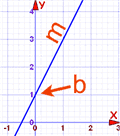 |
Vertical Lines
But this does not work for vertical lines ... I explain why at the end.
Not The Same Line
Be careful! They may be the same line (but with a different equation), and so are not really parallel.
How do we know if they are really the same line? Check their y-intercepts (where they cross the y-axis) as well as their slope:
Perpendicular Lines
Two lines are Perpendicular if they meet at a right angle (90°).
How do we know if two lines are perpendicular?
When we multiply their slopes, we get −1
Like this:
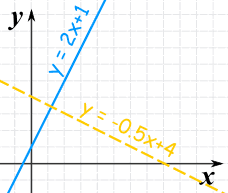
These two lines are perpendicular:
| Line | Slope |
| y = 2x + 1 | 2 |
| y = −0.5x + 4 | −0.5 |
Because when we multiply the two slopes we get:
2 × (−0.5) = −1
Using It
Let's call the two slopes m1 and m2:
m1m2 = −1
| Which can also be: | m1 = −1/m2 | |
| or | m2 = −1/m1 |
So to go from a slope to its perpendicular:
- calculate 1/slope (the reciprocal)
- and then the negative of that
In other words the negative of the reciprocal.
Vertical Lines
The previous methods work nicely except for one particular case: a vertical line:
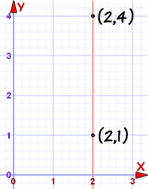
In that case the gradient is undefined (because we cannot divide by 0):
| m = |
| = |
| = |
| = undefined |
So just rely on the fact that:
- a vertical line is parallel to another vertical line.
- a vertical line is perpendicular to a horizontal line (and vice versa).
Equation of straight line
Equation of a Straight Line
The equation of a straight line is usually written this way:
y = mx + b
(or "y = mx + c" in the UK see below)
What does it stand for?
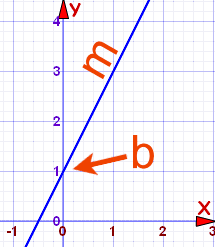
 | |
| Slope (or Gradient) | Y Intercept |
y = how far up
x = how far along
m = Slope or Gradient (how steep the line is)
b = the Y Intercept (where the line crosses the Y axis)
How do you find "m" and "b"?
- b is easy: just see where the line crosses the Y axis.
- m (the Slope) needs some calculation:
| m = |
|  |
Knowing this we can work out the equation of a straight line:
Example 1
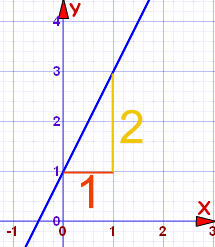
| m | = |
| = | 2 |
b = 1 (where the line crosses the Y-Axis)
| So: y = 2x + 1 |
With that equation you can now ...
... choose any value for x and find the matching value for y
For example, when x is 1:
y = 2×1 + 1 = 3
Check for yourself that x=1 and y=3 is actually on the line.
Or we could choose another value for x, such as 7:
y = 2×7 + 1 = 15
And so when x=7 you will have y=15
Example 2
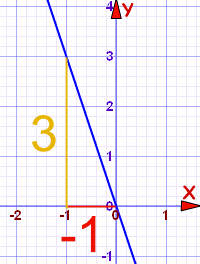
| m | = |
| = | −3 |
b = 0
This gives us y = −3x + 0
We do not need the zero!
| So: y = −3x |
Example 3: Vertical Line
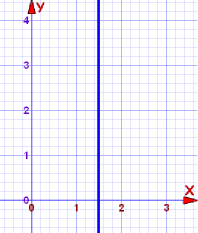
What is the equation for a vertical line?
The slope is undefined ... and where does it cross the Y-Axis?
In fact, this is a special case, and you use a different equation, not "y=...", but instead you use "x=...".
Like this:
x = 1.5
|
Every point on the line has x coordinate 1.5,
that is why its equation is x = 1.5
Examples
The straight line L1 passes through the points
(-1, 3) and (11,12).
(a) Find an equation for L1 in the form of
ax + by + c = 0, where a, b and c are integers.
The line L2 has an equation 3y + 4x - 30 = 0.
(b) Find the coordinates of the point of intersection
of L1 and L2
Solution
You can also look into











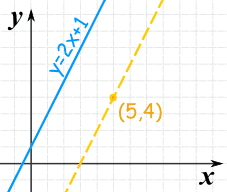
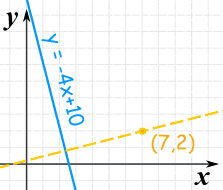



No comments:
Post a Comment